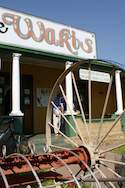New Technologies

The iron age was brought to southern Africa by the Bantu, who arrived from the north.
These migrants brought with them new technologies, such as metal work, agriculture and domesticated animals, and they are known to have settled in northern South Africa by around 500AD.
This is the start of the Early Iron Age in the sub-continent.
As they spread further south, the Bantu began to differentiate into several groups, each with their own dialect and culture based on common ‘Ntu’ roots.
In the interior of the country, these people would become the Sotho-Tswana tribes who inhabit the area today.
On the coast, they would become the Swazi, Zulu and Xhosa nations.
Late Iron Age
By 1300AD, the social organisation and technological achievements of the Bantu had advanced to such a degree that we identify the subsequent era as the Late Iron Age. During this time, the early Sotho-Tswana tribes tended to settle in large stone-walled settlements, sometimes totalling thousands of people.
This pattern was first identified at places such as Mapungubwe, another one of South Africa’s World Heritage sites. By the 1800s, some of these settlements had grown into urban areas with a population of over 15 000. The important town of Kaditshwene, for example, was described with awe and respect by early white missionaries in the area.
About 10 iron-age settlements, with their characteristic dry stone-walling, have been identified in the Dome region so far. None of them seems to have been particularly big, but they are well-preserved and several archaeologists have motivated for additional protection and excavation of the remaining structures.
Vredefort settlements
The layout of the Vredefort settlements echoes the dominant Central Cattle Pattern that was evident throughout the country at the time. This is a spatial organisation of huts around a central cattle kraal, and represented a social hierarchy in which cattle were a sign of wealth and prestige.
Accordingly, the chief lived at the head of the kraal and his subjects’ huts were arranged in descending order of importance around the periphery. The Cattle Kraal was the man’s domain, and they would meet in or near the kraal to resolve disputes or discuss village policy. In Sotho, this area is called the ‘kgotla’ (meeting place). Traditionally, men were buried in the cattle kraal.
The woman’s domain, on the other hand, was the home – no surprises there. Each hut usually included a front courtyard for greeting visitors and a rear courtyard for the preparation of food. Females were traditionally buried in this kitchen area at the back of the hut.
Iron-Age Settlements
Other common structural features of the Vredefort iron-age settlements include grain pits, middens (rubbish and ash tips) and raised granaries. Fragments of broken pottery, storage vessels and grind stones are found at most sites.
Sadly, archaeological studies of Bantu iron-age settlements were not considered a priority during the apartheid years, as any history involving the blacks was considered unimportant or potentially dangerous. Therefore, many of the Vredefort settlements were barely examined by the academics of the day.
This attitude has changed considerably in the last few decades, however, and research on iron-age settlements and culture is currently booming across South Africa. One of the most extensive recent excavations in the Vredefort area took place at a site called Askoppies (Ash Hill), so named because of the hundreds of ash heaps (middens) found around the settlement.
The Askoppies complex stretches over an area of several square kilometers, containing between 8 and 15 distinct settlement units. Each of these free-standing ‘suburbs’ was neatly demarcated by a series of interlocking scallop-shaped stone walls, which defined the outer boundary of the settlement and divided the individual living units within.
The ‘dry’ walls were created by carefully stacking up rocks and boulders found in the surrounding area, and mortar or mud was not generally used. Bear in mind that these walls are not part of the hut, which was made of clay or mud, but rather like a garden fence that ran between the houses.
The People of Askoppies
Dating of material found at Askoppies indicates that the site was inhabited from the 1680s to the early 1800s. A large number of grain bins, found both behind the houses and in the central kraal area, indicates that they were harvesting grains and cereals with considerable success.
Sorghum is thought to have been the major crop. Although cattle were revered as a form of currency, they were also eaten by the people of Askoppies, along with other domestic animals, such as sheep, goats and chicken. Nevertheless, wild animals, such as steenbok, zebra and blesbuck, accounted for about 50% of their diets, so hunting was still an important activity.
Smaller critters (rabbit, tortoise and guinea fowl) and fish from the river were also consumed. In terms of industry, Askoppies conforms to many other iron-age sites around the country. Bone and stone tools were found, including scapers and needles, which indicates that the people were preparing and processing hides (both leather from the cows and pelts from leopard and cheetah).
Objects of personal adornment, such as ivory bangles, glass beads and cowrie shells, were uncovered, and these highly desirable status symbols suggest that the people of Askoppies were at least peripherally involved in the extensive trade network between the interior and the east coast.
Copper earrings were also dug up, along with remnants of iron hoes and spears, which shows that the people were engaged in metal working and smithing. Askoppies is now on private land but is accessible through accredited tour operators who have secured permission from the farm owner to visit the site.
By David Fleminger